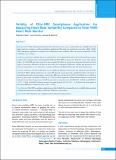Please use this identifier to cite or link to this item:
https://hdl.handle.net/20.500.14356/1215| Title: | Validity of Elite-HRV Smartphone Application for Measuring Heart Rate Variability Compared to Polar V800 Heart Rate Monitor |
| Authors: | Chhetri, Praghosh Shrestha, Lava Mahotra, Narayan B |
| Citation: | ChhetriP., ShresthaL., & MahotraN. B. (2022). Validity of Elite-HRV Smartphone Application for Measuring Heart Rate Variability Compared to Polar V800 Heart Rate Monitor. Journal of Nepal Health Research Council, 19(04), 809-813. https://doi.org/10.33314/jnhrc.v19i04.3949 |
| Issue Date: | 2021 |
| Publisher: | Nepal Health Research Council |
| Article Type: | Original Article |
| Keywords: | Elite HRV heart rate variability time domain indices Polar V800 |
| Series/Report no.: | Oct-Dec, 2021;3949 |
| Abstract: | Abstract Background: With technological advancement, it has become very easy to obtain heart rate variability data with handy heart rate monitors as well as smartphone applications. This study was conducted to assess the validity of Elite HRV smartphone application to measure time domain heart rate variability indices at rest, in comparison to Polar V-800 heart rate monitor. Methods: Heart rate variability data were acquired from twenty apparently healthy male medical students in supine position after simultaneously connecting Polar V800 and Elite HRV to chest-worn Polar H7 sensor. Time domain indices viz. Mean RR intervals, mean heart rate, standard deviation of normal to normal intervals and root mean square of successive differences of interval were taken for comparison. Difference, validity and agreement were assessed using students t-test, intraclass correlation coefficient and Bland Altman plot and limits of agreement. Results: Students t-test showed that there was no significant difference between the data obtained from Elite HRV and Polar V-800 in all the parameters viz. mean RR intervals, mean heart rate, standard deviation of normal to normal intervals and root mean square of successive differences of interval (p>0.05). Correlation was excellent as shown by Intra-class correlation coefficient of >0.999 in all the parameters. Bland Altman analysis revealed small bias and narrow limits of agreement with all the parameters: mean heart rate [-0.003 (0.05 - 0.04)], mean RR [0.01 (-0.58 – 0.60)], standard deviation of normal to normal intervals [-0.01 (-0.32 – 0.30)] and root mean square of successive differences of interval [-0.05 (-0.89 – 0.79)]. Conclusions: Elite HRV smartphone application provided reliable time-domain heart rate variability data consistent with the data obtained from validity tested Polar V800 heart rate monitor. Keywords: Elite HRV; heart rate variability; Polar V800; time domain indices. |
| Description: | Original Article |
| URI: | http://103.69.126.140:8080/handle/20.500.14356/1215 |
| ISSN: | Print ISSN: 1727-5482; Online ISSN: 1999-6217 |
| Appears in Collections: | Vol. 19 No. 04 (2021): Vol 19 No 4 Issue 53 Oct-Dec 2021 |
Files in This Item:
| File | Description | Size | Format | |
|---|---|---|---|---|
| 3949-Manuscript-26794-1-10-20220313.pdf | Fulltext Download | 513.69 kB | Adobe PDF |  View/Open |
Items in DSpace are protected by copyright, with all rights reserved, unless otherwise indicated.
